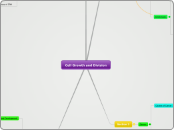Cell Growth and Division
Section 2
Chromosomes
Eukaryote Chromosomes
Generally have more DNA than prokaryotes
Chromatin is chromosomes and histones
Contain multiple chromosomes
DNA and histone molecules form structures called nucleosomes
Chromosomes make it possible to split the DNA correctly in cell division
Prokaryote Chromosomes
Lack nuclei
Contain a single, circular DNA chromsomes
Circle chromosome contains all or almost all genetic infromation
DNA molecules found in cytoplasm
Most of the contents of the cell are in the cytoplasm
Cell Cycle
Eukaryote Cell Cycle
Four phases involved
G1, S, G2, M phase
Time taken in each depends on each type of cell
Interphase is an in-between stage from one cell division to another G1, S, G2 are apart of interphase
Mitosis is the first step in the division of the cell's nucleus, second step is cytokinesis
Prokaryote Cell Cycle
3 main stages
Cell start to begin to start the process when they have grown to a certain size
Process of cell division in prokaryotes is known as Binary Fusion
1. DNA duplicates
2. Cell membrane indents
3. Cell divides with the product of 2 new cells
Mitosis
Prophase
1st phase
Usually longest step
Chromosomes visible and spindle form
Spindle fibers extend from the centrioles
When done chromosomes coil and nucleus disappears
Metaphase
2nd Stage
Generally the shortest step
Chromosomes line up
Spindle fibers attach
Spindle fibers come from both sides of the cell
Anaphase
3rd stage
Begins with chromatids separate ad move away
Chromosomes separate into 2
Move with spindle fibers to sides of cell
Ends when chromosomes are separated into 2 groups
Telephase
Final stage of mitosis
Chromosomes unravel into tangle of chromatin
Nuclear envelope reappears
Spindle fibers break apart and nucleuolus becomes visible
NOT the final stage in cell division, only in mitosis!!!
Cytokinesis
Animal Cells
Cytokinesis is final stage in cell division
Splits one cell into two
Cell membrane is pulled inward
Pinches in until cytoplasm is into nearly 2 parts
Each part contains a nucleus and organelles
Plant Cells
Can't draw inward because it has a rigid cell wall
Cell plate forms forms halfway, dividing the nuclei
Final stage in cell division
Cell plate grows into cell membranes splitting the cell
Spilt cell into two
Section 3
Cancer
Causes of Cancer
Caused by defects in genes that regulate growth and division
Sources- smoking, chewing, radiation exposure, genes defect, and viral infection
Control over cell broken down
Some cells don't respond to external growth regulators
Others don't respond to internal regulators
Treatments
When cancer tumor is localized, removed by surgery
Some can be stopped if found early
Use targeted radiation for cancers that grow rapidly
Chemotherapy slows cells growth process down
Chemo has dangerous side effects because also affects healthy cells
section 1
Cell division and reproduction
Asexual reproduction
One parent
Offspring is identical to parent
Enables populations to increase very rapidly
Definition- production of genetically identical offspring from one parent
Usually in single-celled organisms,but is found in many multi-celled too
Sexual reproduction
Two parents
Offspring shares features from both parents
Is the fusion of two separate parent cells
Offspring inherit genetic information from both parents
Most animals an plants produce sexually
Comparing Asexual and Sexual reproduction
For many single-celled organisms asexual is a form of survival
Asexual only have to have one parent, makes reproducing faster and easier
Sexual reproduction provides more diversity
Some organisms produce asexually and sexually
Sexual, some offspring may have the right combination of genes to survive while others may not
Limits to cells size
Information overload
Happens when cell is too big
DNA has too many things to do
Causes cell to divide
Critical information stored in DNA moleclue
As size of cell increases, DNA does not
Exchanging materials
Food, oxygen, and water enter through the cellular membrane
Waste products leave through cell membrane
Exchange of materials depends on surface area of cell
Rate of food and water being used up and waste produced depends on cell volume
Formula for area- length x width
Formula for volume- length x width x height
Division of Cell
The process of a cell dividing into two daughter cells is called cell division
Daughter cells are what the two cells that divided are called
Before division a cell copies all of it's DNA
Results in an increase in the ratio of surface area to volume
Each daughter cell gets one complete copy of DNA
Section 4
Stem Cells and Development
Human Development
Blastocyst, a hollow ball of cells
At early stage blastocyst begin to specialize
Totipotent- able to develop into any cell
Outer cells form tissue, while cells become part of embryo mass
Inner cells are pluripotent- can't develop into ANY cell
Stem Cells
Unspecialized cells
Embryonic cells are pluripotent, found in early embryo
Stem cells are multipotent- can develop into many types of different cells
Embryonic cells develops after fertilization
Different cells embryonic develop are neurons, fat cells, smooth muscle, and macrophage
Frontiers in Stem Cell Research
Potential Benefits
Scientists are using stem cells to make organs
Offer the chance to inject stem cells into damaged area
Some want to use Embryonic cells to make more cells for other organs
Make whole organs
Could end up saving peoples' lives
Ethical Issues
Harvesting embryonic cells means to kill the embryo
People think it's wrong to kill a human
Some argue that the embryo is not yet alive
Subtopic
The use of stem cell is fine, doesn't hurt anything or one
Most people are confused between stem cells and embryonic cells
